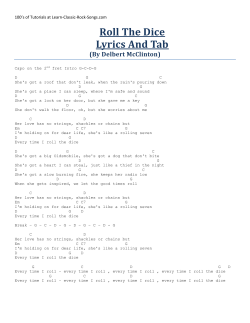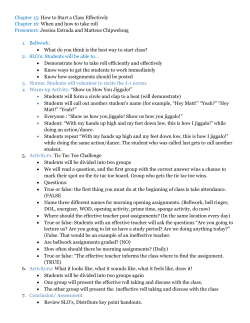
Probability Probability: A measure of the chance that something will
University of California, Los Angeles
Department of Statistics
Statistics 100A
Instructor: Nicolas Christou
Probability
Probability: A measure of the chance that something will occur.
1. Random experiment:
A process that results in one of possible outcomes. The outcomes
cannot be predicted with certainty.
Examples: Flip a coin, roll a die, roll two dice, draw a card, etc.
2. Sample space of a random experiment:
It is the list of all possible outcomes of the random experiment,
denoted with S.
Examples:
a. Flip a coin: S = {H, T }.
b. Flip two coins: S = {HH, T T, HT, T H}.
c. Roll a die: S = {1, 2, 3, 4, 5, 6}.
d. Draw a card: S = {A♣, A♠, A♦, A♥, · · ·} (all 52 cards).
3. Event:
It is the outcome of an experiment, denoted with uppercase letter. It is a subset of the sample space.
Examples:
a. Flip a coin: A = {H}.
b. Roll a die: A = {even number}, B = {odd number}, C = {1, 2, 3}.
d. Draw a card: A = {Ace}, C = {Clubs}.
4. Probability of an event A for equally likely outcomes:
P (A) =
number of ways in which A occurs
number of ways in which all outcomes occur
1
Examples:
a. Draw a card. Let A = {Ace}. Then P (A) =
4
52 .
b. Roll two dice. There are 6 × 6 possible outcomes. The sum of the two numbers rolled
are shown below:
1
2
3
4
5
6
1
2
3
4
5
6
2
3
4
5
6
7
3
4
5
6
7
8
4
5
6
7
8
9
5
6
7
8
9
10
6
7
8
9
10
11
7
8
9
10
11
12
Let A = {sum=5}. Then P (A) =
4
36 .
4. Basic principle of counting: If an experiment has m outcomes
and if for every outcome of this experiment there are n outcomes of another experiment then all together there are m × n
outcomes.
Examples:
a. Roll two dice: 6 × 6 = 36 outcomes.
b. Flip two coins: 2 × 2 = 4 outcomes.
Similarly:
a. Roll three dice: 6 × 6 × 6 = 216 outcomes.
b. Flip three coins: 2 × 2 × 2 = 8 outcomes.
2
Union of two events A, B
The union of two events A, B, denoted A ∪ B, is a new event.
It is defined as the event containing all outcomes in A or B or
BOTH. Similarly the union of n events A1, A2, · · · , An is denoted
with A1 ∪ A2 ∪ · · · ∪ An. Key word: OR.
Example: Suppose 50 students can be classified by their major and year as follows:
Econ
Math
Total
Sop.
10
5
15
Jun.
20
4
24
Sen.
6
5
11
Total
36
14
50
A student is selected at random from this group of 50 students. Let A = {student is senior}, and
B = {student is math major}. Find P (A ∪ B).
Intersection of two events A, B
The intersection of two events A, B, denoted A ∩ B, is a new event.
It is defined as the event containing all outcomes that belong to both
A and B. Similarly the intersection of n events A1, A2, · · · , An is
denoted with A1 ∩ A2 ∩ · · · ∩ An. Key word: AND.
Example: Using the table above find P (A ∩ B).
Example: Draw a card at random. Let A = {card is clubs} and B = {card is ace or 4}. Find
P (A ∩ B). Also find P (A ∪ B). Use a Venn diagram to show these events.
3
Algebra of sets
a. Cumulative laws:
A ∪ B = B ∪ A.
A ∩ B = B ∩ A.
b. Associative laws:
A ∪ B ∪ C = (A ∪ B) ∪ C = A ∪ (B ∪ C).
A ∩ B ∩ C = (A ∩ B) ∩ C = A ∩ (B ∩ C).
c. Distributive laws:
(A ∪ B) ∩ C = (A ∩ C) ∪ (B ∩ C)
(A ∩ B) ∪ C = (A ∪ C) ∩ (B ∪ C)
Mutually exclusive events
It is said that two events A, B are mutually exclusive, (or disjoint) if
A, B have no outcomes in common. It follows that A, B are disjoint
if A ∩ B = {∅}. Therefore, if A, B are disjoint then P (A ∩ B) = 0.
Example: Roll a die. Let A = {even number}, B = {odd number}. The events A, B are mutually
exclusive and we can represent them as follows using a Venn diagram.
4
Axioms of Probability
1. 0 ≤ P (A) ≤ 1.
2. P (S) = 1.
3. The union for any sequence of mutually exclusive events A1, A2, · · ·
is equal to P (A1 ∪ A2 · · ·) = P (A1) + P (A2) + · · ·
Let A, B two mutually exclusive event. Then the union of the
two events is equal to P (A ∪ B) = P (A) + P (B).
Complement events
The complement of an event A, denoted with A0 or Ac, is defined to
be the event that contains all the outcomes in the sample space that
do not belong to A.
Are A, A0 mutually exclusive?
5
Conditional Probability
Let two events A and B. Suppose that event B has already occured.
Given this information, what is the probability of event A. This is
called “conditional probability” denoted with P (A|B) and we read:
the probability of A given B. It is equal to:
P (A|B) =
P (A ∩ B)
P (B)
Similarly,
P (B|A) =
P (A ∩ B)
P (A)
Example: Roll a die. Let A = {2}, and B = {even number}. Draw the two events using a venn
diagram. Find P (A|B).
6
• Multiplication rule
Let events A, B. The probability of A and B (i.e. the probability
of the intersection A, B) can be computed as follows:
P (A ∩ B) = P (A|B)P (B) = P (B|A)P (A).
Example:
Draw two cards without replacement. Let’s define the events A1 , A2 as follows:
A1 = {the first card is an ace}, and A2 = {the second card is an ace}. Find the probability
that both cards are aces.
• Independent events
The events A, B are independent if the occurrence of one of
them does not affect the occurrence of the other event. If A, B
are independent then, P (A|B) = P (A), and the multiplication
rule is: P (A ∩ B) = P (A)P (B).
Example: Draw two cards with replacement. Let’s define the events A1 , A2 as follows:
A1 = {the first card is an ace}, and A2 = {the second card is an ace}. Find the probability
that both cards are aces.
7
• Addition rule
Let events A, B. The probability of A or B or BOTH (i.e. the
probability of the union A, B) can be computed as follows:
P (A ∪ B) = P (A) + P (B) − P (A ∩ B). It follows directly from
the Venn diagram.
• If A, B are mutually exclusive events then P (A ∩ B) = 0, and
the addition rule is:
P (A ∪ B) = P (A) + P (B) (this is Axiom 3).
• If A, B are independent, can they be mutually exclusive?
8
Examples:
1. Draw two cards with replacement. Let’s define the events A1 , A2 as follows:
A1 = {the first card is an ace}, and A2 = {the second card is an ace}. Find the probability
that the first card is an ace or the second card is an ace, or both cards are aces. Or simply
we can ask: Find the probability that we observe at least one ace.
2. Two dice are rolled 10 times. Find the probability that in these 10 rolls we observe the sum
of 5 at least once.
9
De Morgan’s Law
Very useful!
Using De Morgan’s law we can find the probability of the union of the
complements and the intersection of the complements of a number
of events. More specifically:
P (A0 ∩ B 0) = 1 − P (A ∪ B)
and
P (A0 ∪ B 0) = 1 − P (A ∩ B)
Use a Venn diagram to show these results.
10
Law of total probability
Decomposition rule
Let event A, B as shown in the figure below.
Event A can be expressed as:
A = (A ∩ B) ∪ (A ∩ B 0)
The events A ∩ B and A ∩ B 0 are mutually exclusive and therefore
from Axiom 3 we have:
A = (A ∩ B) + (A ∩ B 0)
Using the multiplication rule the above can be expressed as:
P (A) = P (A|B)P (B) + P (A|B 0)P (B 0)
This is called the law of total probability or decomposition rule. It
allows us to compute the probability of an event when it is not easy
to compute it directly. This rule can be extended to more than
two events. If A intersects with the events B, C and D we have:
P (A) = P (A|B)P (B) + P (A|C)P (C) + P (A|D)P (D).
11
Examples:
1. A blood test is 95% effective in detecting a certain disease when the disease in fact is present.
The test also yields a false positive result 1% of the healthy persons tested. Suppose that
0.5% (0.005) of the population actually has the disease.
a. A person will be tested for the disease. Find the probability that the test will be
positive.
b. Suppose that a person was found positive. Find the probability that the person actually
has the disease.
2. There are 2 urns. In the first urn there are 5 green balls and 4 blue balls. In the second urn
there are 4 white balls, 2 yellow balls, and 2 green balls. One ball is drawn at random from
the first urn and it is placed in the second urn. Then a ball is drawn at random from the
second urn.
a. Find the probability that the ball drawn from the second urn is green.
b. Given that the ball drawn from the second urn is green what is the probability that the
ball drawn from urn 1 was also green.
3. A machine that produces parts for cars is in good condition 90% of the time. When the
machine is in good condition 1% of the parts are defective. When it is not in good condition
15% of the parts are defective.
a. Find the probability that a randomly selected part is defective.
b. Suppose that a randomly selected part was found to be defective. What is the probability that the machine was not in good condition?
4. The marketing manager of a toy manufacturing firm is planning to introduce a new toy into
the market. In the past, 40% of the toys introduced by the company have been succesful
and 60% have not been succesful. Before the toy is actually marketed, market research is
conducted and a report, either favorable or unfavorable, is compiled. In the past, 80% of
the succesful toys received favorable reports and 30% of the unsuccesful toys also received
favorable reports.
a. What proportion of the new toys receive favorable market research reports?
b. Suppose that market research gives a favorable report on a new toy. What is the
probability that the new toy will be succesful?
12
Probability - Summary
• Conditional probability:
P (A|B) =
P (A ∩ B)
P (B)
P (B|A) =
P (A ∩ B)
P (A)
• Multiplication rule:
P (A ∩ B) = P (A|B)P (B) = P (B|A)P (A)
If A, B are independent then P (A ∩ B) = P (A)P (B).
• Addition rule:
P (A ∪ B) = P (A) + P (B) − P (A ∩ B)
If A, B are mutually exclusive then P (A ∪ B) = P (A) + P (B).
• De Morgan’s Law:
P (A0 ∩ B 0) = 1 − P (A ∪ B)
P (A0 ∪ B 0) = 1 − P (A ∩ B)
• Useful result (complement events):
P (A) + P (A0) = 1 ⇒ P (A0) = 1 − P (A)
and
P (A|B) + P (A0|B) = 1
• If A, B are mutually exclusive then P (A|B) = 0 and if A, B are
independent then P (A|B) = A.
13
Probability - examples
Example 1:
For each of the following, list the sample space and tell whether you think the events are equally likely.
a. Roll two dice; record the sume of the numbers.
b. A family has 3 children; record the genders in order of birth.
c. Toss 4 coins; record the number of tails.
d. Toss a coin 10 times.; record the longest run of heads.
Example 2:
Suppose the probability that a U.S. resident has traveled to Canada is 0.18, to Mexico is 0.09, and to both countries s 0.04. What is the probability
that an American chosen at random has
a. traveled to Canada but not to Mexico?
b. traveled to either Canada or Mexico?
c. not traveled to either country?
Example 3:
Employment data at a large company reveal that 72% of the workers are married, that 44% are college graduates, and that half of the grads are
married. What is the probability that a randomly chosen worker
a. is neither married nor a college graduate?
b. is married but not a college graduate?
c. is married or a college graduate?
Example 4:
Seventy percent of kids who visit a doctor have fever, and 30% of kids with fever have sore throats. What is the probability that a kid who goes
to the doctor has a fever and a sore throat?
Example 5:
You pick three cards at random from a deck. Find the probability of each event described below.
a. You get no aces.
b. You get all hearts.
c. The third card is your first black card.
d. You have at least one diamond.
Example 6:
The soccer team’s shirts have arrived in a big box, and people just start grabbing them, looking for the right size. The box contains 4 medium, 10
large, and 6 extra-large shirts. You want a medium for you and one for your sister. Find the probability of each event described.
a. The first two you grab are the wrong sizes.
b. The first medium shirt you find is the third one you check.
c. The first four shirts you pick are all extra-large.
d. At least one of the first four shirts you check is a medium.
Example 7:
Given the table below, are high blood pressure and high cholesterol independent? Explain.
Cholesterol
High
OK
Blood Pressure
High
OK
0.11
0.21
0.16
0.52
Example 8:
Suppose that 23% of adults smoke cigarettes. It is known that 57% of smokers and 13% of nonsmokers develop a certain lung condition by age 60.
a. Explain how these statistics indicate that lung condition and smoking are not independent.
b. What is the probability that a randomly selected 60-year-old has this lung condition?
14
Example 9:
The 60 students of a statistics class can be classified as below according to their academic status and whether they live on or off campus.
On campus
Off campus
Total
Sophomore
15
5
20
Junior
10
5
15
Senior
15
10
25
Total
40
20
60
A student from this class is selected at random. Let the events A, J, C, S be as follows: A = {senior}, J = {junior}, C = {on campus},
S = {sophomore}. Find the probability that the student:
a. lives on campus.
b. is a senior.
c. does not live on campus.
d. lives on campus and is a junior.
e. lives on campus or is a junior.
f. neither lives on campus nor is a junior.
g. does not live on campus given that he is a senior.
h. lives on campus given that he is a senior.
i. is a senior and sophomore.
j. lives on campus or lives off campus.
k. lives on campus and is not senior.
l. does not live on campus or is not a sophomore.
m. Are the events senior and campus independent?
Example 10:
An unbiased die in the shape of regular dodecahedron has twelve faces with the numbers 2,2,4,4,4,6,6,10,10,10,12,12, shown separately on the faces.
The result of a throw is the number shown on the uppermost face. Each of four players throws the die twice and scores the sum of the two results.
a. What is the probability that a player will get a score greater than six? (Ans. 0.8888).
b. What is the probability that exactly one of the four players will get a score greater than six? Assume that their scores are independent
from one another. (Ans. 0.0049).
Example 11:
The color of a person’s eyes is determined by a single pair of genes. If they are both blue-eyed genes, then the person will have blue eyes; if they
are both brown-eyed genes, then the person will have brown eyes; and if one of them is blue-eyed gene and the other a brown-eyed gene, then the
person will have brown eyes (because of the latter fact we say that the brown-eyed gene is dominant over the blue-eyed one). A newborn child
independently receives one eye gene from each of its parents and the gene it receives from a parent is equally likely to be either of the two gnes of
that parent. Suppose that person A and both of his parents have brown eyes, but person A’s sister has blue eyes.
2 ).
a. What is the probabilty that person A possesses a blue-eyed gene? (Ans. 3
Suppose person A’s wife has blue eyes.
b. What is the probability that their first child will have blue eyes? (Ans. 1
).
3
Problem 12
On the figure below you see an electric system with three components that operate independently each one with probability 95%.
a. Find the probability that current will flow from point 1 to point 2.
b. Given that current flowed from point 1 to point 2, what is the probability that component A functioned?
c. Let X be the number of paths that allow current to flow from point 1 to point 2. Construct the probability distribution of X. Note:
AB 0 C 0 is one path because A functions while B and C do not function. Also, X takes the value 0, 1, 2, 3. If x = 0 then there is no path
that allows current to flow, while if x = 3 there are three paths that allow current to flow, etc.
Problem 13
A medical doctor thinks carefully about the following dilemma: “If I am at least 80 percent certain that my patient has this disease, then I always
recommend surgery. If am not so certain, then I recommend additional tests that are expensive and sometimes painful. Now, initially I was only
60 percent certain that patient X had the disease, so I ordered test A. Test A always gives positive result if the patient has the disease. The test
was positive for patient X and I was ready to recommend surgery when X informed me, for the first time, that he is diabetic. This information
complicates matters! I still believe that the probability that X has the disease is 60 percent but the interpretation of the results of test A should
be different. This is because test A yields false positive result 30 percent of the time in the case of a diabetic patient. Now what do I do? Should
I recommend surgery?” Let denote with D the event that patient X has the disease, and with E the event that test A is positive.
a. Compute the probability that test A is positive.
b. Should the doctor recommend surgery? To help the doctor compute the probability that the patient has the disease given that the test
is positive.
15
The game of craps
A popular gambling game called craps is described below. A player rolls two dice, and the
sum of the two numbers that appear is recorded. If the sum on the first roll is 7 or 11, the
player wins immediately and the game stops. If on the first attempt a sum of 2, or 3, or 12
is scored, the player loses the game immediately. If the sum on the first roll is 4, 5, 6, 8, 9,
or 10, then the two dice are rolled again until either the sum of 7 is scored or the original
sum is scored. If the original sum is obtained a second time before 7, then the player wins.
If the sum of 7 is obtained before the original sum is obtained a second time, then the player
loses. Here are some examples:
First roll: sum is 11 then player wins.
First roll: sum is 12 then player loses.
First roll: sum is 5, second roll: sum is 5 then player wins.
First roll: sum is 8, second roll: sum is 2, third roll: sum is 8, then player wins.
First roll: sum is 4, second roll: sum is 11, third roll: sum is 7, then player loses.
Compute the probability that the player will win.
16
© Copyright 2025









